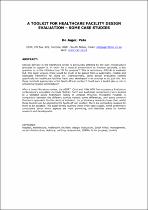JavaScript is disabled for your browser. Some features of this site may not work without it.
- ResearchSpace
- →
- Research Publications/Outputs
- →
- Conference Publications
- →
- View Item
| dc.contributor.author |
De Jager, Peta

|
|
| dc.date.accessioned | 2009-01-09T06:56:45Z | |
| dc.date.available | 2009-01-09T06:56:45Z | |
| dc.date.issued | 2007-10 | |
| dc.identifier.citation | de Jager, P. 2007. Toolkit for healthcare facility design evaluation - some case studies. South African Federation of Hospital Engineering (SAFHE) and Clinical Engineering Association of South Africa (CEASA) national biennial conference and exhibition 2007, Port Elizabeth, South Africa, 17-19 October, 2007, pp 9 | en |
| dc.identifier.isbn | 9780620384810 | |
| dc.identifier.uri | http://hdl.handle.net/10204/2777 | |
| dc.description | 2007: SAFHE & CEASA National Biennial Conference and Exhibition | en |
| dc.description.abstract | Service delivery in the healthcare sector is profoundly affected by the built infrastructure provided to support it. In order for a hospital environment to function optimally, a key question is, is the infrastructure "fit for purpose"? This is notoriously difficult to evaluate but, this paper argues, there would be much to be gained from a systematic, reliable and replicable framework for doing so. Internationally, some design evaluation toolkits specifically for healthcare facilities have been developed in an attempt to do just this. Are these methods appropriate in the South African context? Could such a toolkit play a role in enhancing hospital architecture? After a broad literature review, the AEDET, QIND and NSW HFG Post-occupancy Evaluation contemporary evaluation methods (British, Dutch and Australian respectively) were applied to a selected public healthcare facility in Limpopo Province, Mokopane Hospital. A comparison between the different toolkits reveals some differences, and some common themes in approach. Further study is indicated, but preliminary research shows that, whilst these toolkits can be applied to the South African context, there are compelling reasons for them to be adapted. This paper briefly outlines these three case studies, some preliminary conclusions about which aspects are most promising, and identifies areas for further research and development. | en |
| dc.language.iso | en | en |
| dc.subject | Design | en |
| dc.subject | South Africa | en |
| dc.subject | Hospital | en |
| dc.subject | Architecture | en |
| dc.subject | Healthcare | en |
| dc.subject | Facilities | en |
| dc.subject | Social | en |
| dc.subject | Infrastructure | en |
| dc.subject | Toolkits | en |
| dc.title | Toolkit for healthcare facility design evaluation - some case studies | en |
| dc.type | Conference Presentation | en |
| dc.identifier.apacitation | De Jager, P. (2007). Toolkit for healthcare facility design evaluation - some case studies. http://hdl.handle.net/10204/2777 | en_ZA |
| dc.identifier.chicagocitation | De Jager, Peta. "Toolkit for healthcare facility design evaluation - some case studies." (2007): http://hdl.handle.net/10204/2777 | en_ZA |
| dc.identifier.vancouvercitation | De Jager P, Toolkit for healthcare facility design evaluation - some case studies; 2007. http://hdl.handle.net/10204/2777 . | en_ZA |
| dc.identifier.ris | TY - Conference Presentation AU - De Jager, Peta AB - Service delivery in the healthcare sector is profoundly affected by the built infrastructure provided to support it. In order for a hospital environment to function optimally, a key question is, is the infrastructure "fit for purpose"? This is notoriously difficult to evaluate but, this paper argues, there would be much to be gained from a systematic, reliable and replicable framework for doing so. Internationally, some design evaluation toolkits specifically for healthcare facilities have been developed in an attempt to do just this. Are these methods appropriate in the South African context? Could such a toolkit play a role in enhancing hospital architecture? After a broad literature review, the AEDET, QIND and NSW HFG Post-occupancy Evaluation contemporary evaluation methods (British, Dutch and Australian respectively) were applied to a selected public healthcare facility in Limpopo Province, Mokopane Hospital. A comparison between the different toolkits reveals some differences, and some common themes in approach. Further study is indicated, but preliminary research shows that, whilst these toolkits can be applied to the South African context, there are compelling reasons for them to be adapted. This paper briefly outlines these three case studies, some preliminary conclusions about which aspects are most promising, and identifies areas for further research and development. DA - 2007-10 DB - ResearchSpace DP - CSIR KW - Design KW - South Africa KW - Hospital KW - Architecture KW - Healthcare KW - Facilities KW - Social KW - Infrastructure KW - Toolkits LK - https://researchspace.csir.co.za PY - 2007 SM - 9780620384810 T1 - Toolkit for healthcare facility design evaluation - some case studies TI - Toolkit for healthcare facility design evaluation - some case studies UR - http://hdl.handle.net/10204/2777 ER - | en_ZA |






